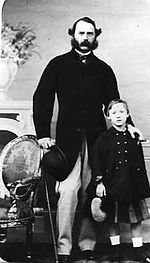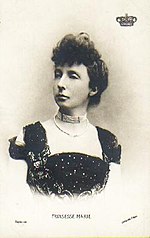Prince Valdemar of Denmark
| Prince Valdemar | |
|---|---|
 Prince Valdemar during a visit to Siam, 1900 | |
| Born | 27 October 1858 Bernstorff Palace, Gentofte |
| Died | 14 January 1939 (aged 80) The Yellow Palace, Copenhagen |
| Burial | |
| Spouse | |
| Issue | |
| House | Glücksburg |
| Father | Christian IX of Denmark |
| Mother | Louise of Hesse-Kassel |
Prince Valdemar of Denmark, GCTE (27 October 1858 – 14 January 1939) was the third son and youngest child of Christian IX and Louise of Hesse-Kassel. He had a lifelong naval career.
Early life

Prince Valdemar was born on 27 October 1858 at Bernstorff Palace in Gentofte north of Copenhagen. His father was Prince Christian of Denmark, later King Christian IX. His mother was Princess Louise of Hesse-Kassel. He was baptised on 21 December 1858.
In March 1863, the Danish royal family, including four-year-old Valdemar, travelled to London for the wedding of his eldest sister, Alexandra, to the Prince of Wales, the son and heir of Queen Victoria. That November, his parents succeeded to the throne of Denmark following the death of King Frederick VII.
Prince Valdemar received his early education from tutors. In the summer of 1874, he accompanied his father during his visit to Iceland for the millennium celebrations. After his confirmation in 1874, as was customary for princes at that time, he started a military education and entered the naval college. In 1879, he was sub-lieutenant and in 1880 lieutenant. In the following years, he participated in several naval expeditions. From 1883, Valdemar lived at Bernstorff Palace near Copenhagen with his nephew Prince George of Greece, who had been taken as a boy to Denmark to be enlisted in the Danish royal navy, and be consigned to the care of Valdemar, who was an admiral in the Danish fleet. Feeling abandoned by his father on this occasion, George would later describe to his fiancée the profound attachment he developed for his uncle from that day forward.[1]
Marriage

He married Princess Marie d'Orleans on 20 October 1885 in a civil ceremony in Paris.[2] They had a religious ceremony on 22 October 1885 at the Château d'Eu, the residence of Prince Philippe, Count of Paris.[2] The wedding was believed by one source to have been politically arranged, and in France, it was believed that the Count of Paris (the bride's uncle) was personally responsible for the match.[2] However, the same source claimed that "there was every reason to believe that [it was] a genuine love match".[2] At the time of their marriage, it was decided that any sons would be brought up in Valdemar's Lutheran faith, while any daughters would be raised as Catholics, the faith of their mother.[3] The couple's four sons were consequently Lutherans, while their only daughter, Margaret was raised a Catholic and married a Catholic prince.[3]
Later life

Valdemar had a lifelong naval career. He was the first president of the Seamen's Association of 1856.
He died on 14 January 1939 in the Yellow Palace in Copenhagen and was buried in Roskilde Cathedral. He was the last surviving child of Christian IX.
Issue
- Prince Aage of Denmark (1887–1940), married Matilda Calvi dei conti di Bergolo in 1914 and had one son
- Prince Axel of Denmark (1888–1964), married Margaretha of Sweden in 1919 and had two sons
- Prince Erik of Denmark (1890–1950), married Lois Frances Booth in Ottawa, Canada 1924, divorced 1937, and had a son and a daughter.
- Prince Viggo of Denmark (1893–1970), created Count of Rosenborg, married Eleonora Green, and had no children
- Princess Margaret of Denmark (1895–1992), married Prince René of Bourbon-Parma. Her daughter Anne was the wife of Michael, former King of Romania.
| Styles of Prince Valdemar of Denmark | |
|---|---|
 | |
| Reference style | His Royal Highness |
| Spoken style | Your Royal Highness |
| Alternative style | Sir |
Titles, styles, honours and arms
Titles and styles
- 27 October 1858 – 14 January 1939: His Royal Highness Prince Valdemar of Denmark
Honours
 United Kingdom - Honorary Knight Grand Cross (Civil) of the Order of the Bath (GCB) - 17 September 1901 - - during a private visit to Denmark by King Edward VII and Queen Alexandra[4]
United Kingdom - Honorary Knight Grand Cross (Civil) of the Order of the Bath (GCB) - 17 September 1901 - - during a private visit to Denmark by King Edward VII and Queen Alexandra[4] Portugal - Grand Cross of the Order of the Tower and Sword - He was the 192nd recipient
Portugal - Grand Cross of the Order of the Tower and Sword - He was the 192nd recipient Thailand - Knight Grand Cordon (Special Class) of the Order of the White Elephant
Thailand - Knight Grand Cordon (Special Class) of the Order of the White Elephant
Ancestry
References
- ^ Bertin, Celia (1982). "A False Happiness". Marie Bonaparte: A Life. New York: Harcourt Brace Jovanovich. pp. 85–86. ISBN 0-15-157252-6.
From that day, from that moment on, I loved him and I have never had any other friend but him...You will love him too, when you meet him.
- ^ a b c d "Royal Marriage Bells", The New York Times, Eu, France, 22 October 1885
- ^ a b Finestone, p. 199.
- ^ "No. 27356". The London Gazette. 17 September 1901. p. 6101.
Sources
- Finestone, Jeffrey (1981). The Last Courts of Europe: A Royal Family Album 1860-1914. London: J. M. Dent and Sons Ltd. ISBN 0-517-41472-4.
External links
- Prince Valdemar at the website of the Royal Danish Collection at Amalienborg Palace

